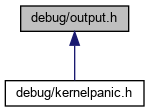|
StuBS
|
Debug macros enabling debug output on a separate window for each core. More...


Macros | |
| #define | DBG_VERBOSE nullstream |
| An output stream, which is only displayed in the debug window in verbose mode. More... | |
| #define | DBG *copyout[Core::getID()] |
| An output stream, which is displayed in the debug window of the core it was executed on. More... | |
Variables | |
| TextStream | dout [Core::MAX] |
| Debug window for the CGA screen. More... | |
| OutputStream * | copyout [Core::MAX] |
| Debug window with copy function to serial. More... | |
Debug macros enabling debug output on a separate window for each core.
| #define DBG *copyout[Core::getID()] |
An output stream, which is displayed in the debug window of the core it was executed on.
In single core (OOStuBS) this is just an alias to the debug window object dout. However, on a multi core system a debug window for each core is required, therefore dout has to be an TextStream object array with the core ID as array index – the selection is done via Core::getID()
| #define DBG_VERBOSE nullstream |
An output stream, which is only displayed in the debug window in verbose mode.
|
extern |
Debug window with copy function to serial.
Provide an additional layer to ouput one debug output also to serial. While this is a simple CopyStream pointer in the single core case, it is an array in the multi core case, which consists of thre TextStreams and one CopyStream. For that, construction is done like:
|
extern |
Debug window for the CGA screen.
Debug output using DBG like DBG << "var = " << var << endl should be displayed in window dedicated to the core it is executed on.
While this is quite easy on single core systems like OOStuBS – they only require a single TextStream object called dout – multi core systems like MPStuBS need an object array with one window per core. In the latter case direct list initialization can be used:
The debug windows in should be located right below the normal output window without any overlap and should be able to display at least 3 lines. In MPStuBS, two windows can be placed side-by-side, having 40 columns each.